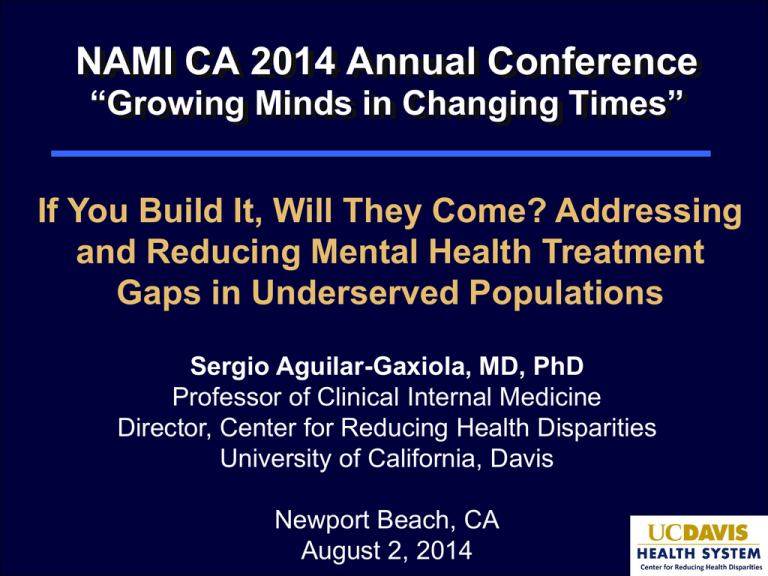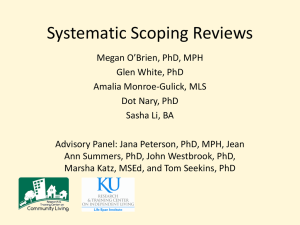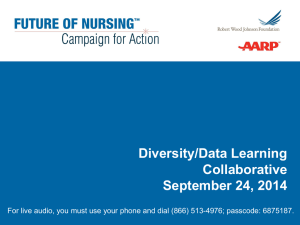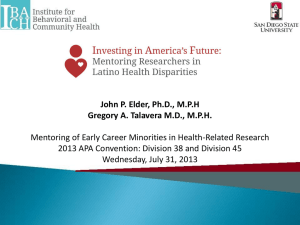If You Build It, Will They Come?
advertisement

NAMI CA 2014 Annual Conference “Growing Minds in Changing Times” If You Build It, Will They Come? Addressing and Reducing Mental Health Treatment Gaps in Underserved Populations Sergio Aguilar-Gaxiola, MD, PhD Professor of Clinical Internal Medicine Director, Center for Reducing Health Disparities University of California, Davis Newport Beach, CA August 2, 2014 Disclosure I have no relevant financial interest/arrangement or affiliation with any organizations related to commercial products or services to be discussed at this presentation Mental and/or substance abuse disorders are major drivers of suffering, disability, cost and are associated with poverty 4 The “Treatment Gap” Between 50 to 90% of people with serious mental disorders have not had received appropriate mental health care in the previous year Treatment Gap in the U.S. Levels of unmet need (not receiving specialist or generalist care in past 12 months, with identified diagnosis in the same period) –Hispanics – 70% –African Americans – 72% –Asian Americans – 78% –Non-Hispanic Whites – 61% Source: Alegria et al., 2006 Mexican American Prevalence and Services Survey (MAPSS) Who Utilized Services? 38% of U.S. born received care 15% of immigrants received care 9% of migrant agricultural workers received care Source: Aguilar-Gaxiola, Vega, et al., 2000 Treatment Gap: Is it Only in the U.S. Serious cases NOT receiving treatment during the past12 months 90 85% 80 76% 70 60 61% 50 40 30 35% 20 10 0 Lower range Upper range Developed countries Lower range Upper range Developing countries Source: Saxena, 2011; Alegria, 2006; WHO World Mental Health Consortium, JAMA, June 2nd, 2004 Why the Treatment Gap? ■ Multiple barriers 1. Individual level (e.g., stigma) 2. Community level (e.g., Lack of culturally and linguistically appropriate services) 3. Systemic level (e.g., Lack of social and economic resources and poor living conditions) ■ Lack of Engagement in Behavioral Healthcare Workforce Challenges in Mental Health ■ ■ ■ ■ ■ ■ High caseloads, “burn out” Prescribers Lack of adequate training and graduate preparation programs Limited training in providing familycentered or recovery-oriented care Lack of positions in the public mental health system for consumers and family members Limited opportunities for advancement Source: Alonzo-Diaz. 2014 Latinos’ Lack of Engagement in Behavioral Healthcare Latinos are more likely than non-Hispanic Whites to terminate treatment prematurely, with as many as 60-75% dropping out after just one session (McCabe, 2002) Mode number of visits is 1 and median is 3 to both psychiatrists and psychologists (Alegria, 2007) Action Needed: Consumer Engagement Untreated Mental Illness Intensify over time…can reduce life expectancy Causes intense and prolonged suffering to individuals and their families Limits individuals’ ability to reach social and educational normative goals Leads to expensive costs to individuals, families, and communities Key Issues In Mental Health Care ■ The 5 A’s: 1. Accessibility 2. Affordability 3. Availability 4. Appropriateness 5. Advocacy How can we transform services and supports to prevent high risk behaviors and improve outcomes especially in underserved populations? Going Beyond Services and Supports Integration of Primary and Behavioral Health Care Adaptations and Practice-based Evidence Community-based Partnerships Community Outreach and Engagement Prevention and Early Intervention and Health Promotion are Key Source: Huang, 2007 “No mass disorder afflicting humankind has been eliminated or brought under control by attempts at treating the affected individual, nor by training large numbers of individual practitioners” George Albee Past President, American Psychological Association The Role of Prevention in Reducing the Treatment Gap Health care is not the primary determinant of health Improving health access is only part of the solution to improving health outcomes and reducing health disparities; There are three reasons why improving access to health care alone will not close the treatment gap: 1. Clinical care treats one person at a time; 2. Intervention often comes late; 3. Clinical care is usually sought after people are sick (“fail first”). Source: Mikkelsen, Cohen, Bhattacharyya, Valenzuela, Davis, & Gantz, 2002 The Role of Prevention in Closing the Treatment Gap Prevention and Early Intervention can make a vital contribution to current efforts to reduce disparities in health. By addressing the underlying factors that negatively influence health and mental health, prevention has the power to reduce the incidence of poor mental health and disability and premature death. Source: Mikkelsen, Cohen, Bhattacharyya, Valenzuela, Davis, & Gantz, 2002 Report of the Committee on the Prevention of Mental Disorders and Substance Abuse IOM Public Briefing March 25, 2009 Washington DC Mental, Emotional and Substance Abuse Disorders Are Common and Costly Around 1 in 5 young people (14-20%) have a current disorder Estimated $247 billion in annual costs Costs to multiple sectors – education, justice, health care, social welfare Costs to the individual and family Preventive Opportunities Early in Life Early onset (75% of adult disorders had onset by age 24; 50% by age 14) First symptoms occur 2-4 years prior to onset of a diagnosable disorder Common risk factors for multiple problems and disorders Prevention Window Core Concepts of Prevention 1. Prevention requires a change in thinking 2. Mental health and physical health are inseparable 3. Successful prevention is inherently interdisciplinary 4. Mental, emotional, and behavioral (MEB) disorders are developmental 5. Developmental perspective is key Preventive Intervention Opportunities Parent hood Two Approaches to Targeting Interventions Target specific disorders -depression, substance abuse, schizophrenia Target risk and protective factors for multiple disorders -poverty, maltreatment, family disruption, community and school risk factors 25 Impressive Evidence of Efficacy Interventions show effects on wide range of serious problems such as substance abuse, depression, antisocial behavior, child abuse Interventions improve positive outcomes such as school success, self-esteem Multi-year effects of some interventions 26 Evidence from Studies that Target Specific Disorders Indications that incidence of adolescent depression can be reduced Emerging evidence to prevent onset of full-blown schizophrenic episodes 27 Long-term Impact of Prevention Teacher training in classroom instruction and management, child social and emotional skill development and parent workshops were the intervention. A significant multi-varied effect across all 16 primary outcome indices were found. Specific effects included significantly better educational and economic attainment, mental health and sexual health by age 27 years. So prevention is possible. Hawkins JD, Kosterman R, Catalano RF, Hill KG, and Abbott RD. Effects of Social Development Intervention in Childhood 15 Years Later. Arch Pediatr Adolesc Med. 162(12), pp 1133-1141, 2008. 28 Community-Defined Solutions for Reducing Mental Health Disparities California Reducing Disparities Project California Reducing Disparities Project Main goal is to develop a Statewide Comprehensive Strategic Plan. Identify community-defined promising practices, models, resources/approaches helpful for county program planners, practitioners, and policy makers in designing programs to better address the needs of these communities. Contribute culturally relevant recommendations from each ethnic/cultural group to develop a comprehensive statewide strategic plan towards the reduction of mental health disparities Source: Guerrero, 2009 CA Reducing Disparities Project: Latino SPW • The Latino Statewide Reducing Disparities Project started July 1, 2010. • The main goal was to produce a community-defined, strength-based, culturally and linguistically appropriate report on reducing disparities in mental health services for Latinos. • Identified and engaged a diverse range of Latino stakeholder representatives at the state, regional, and local levels. • Stakeholders included consumers, providers, public agencies, and representatives of community interests, and have diversity in terms of gender, age, and mental health and health issues. CA Reducing Disparities Project Latino SPW: Governance and Structure Southern Region (includes LA) Northern California Region The Concilio Bay Area Region Central Region Latino Strategic Planning Workgroup – LATINO CONCILIO Website: http://www.latinomentalhealthconcilio.org Forum Sites by City, Region & County Exhibit 5: Forum Sites by City, Region, and County California Reducing Disparities Project Full report (PDF) available at: http://www.latinomentalhealthconcilio.org/mhsa/crdp-latino-population-report/ Spanish version will be soon available Three Major Types of Barriers 1. Individual-Level Barriers – – – – – Stigma Culture Gender (masculinity) Violence and trauma Knowledge and awareness 2. Community-Level Barriers – – – – Lack of culturally and linguistically appropriate services Shortage of bilingual and bicultural mental health workers Lack of school-based mental health programs Organizational and systemic barriers 3. Systemic-Level Barriers – Lack of social and economic resources and poor living conditions – Inadequate transportation – Social exclusion Strategic Directions to Improve Access, Availability, Appropriateness, Affordability, and Advocacy 1. School-based mental health programs; 2. Community-based organizations and colocation of resources; 3. Community and social media; 4. Culturally and linguistically appropriate treatment; 5. Workforce development to sustain culturally and linguistically competent workforce; 6. Community capacity building and community outreach and engagement. Ventura County Strategic Directions: Reducing Disparities* 1. Academic and SchoolBased Mental Health Programs 6. Community Capacity-Building and Outreach and Engagement 2. Community-Based Organizations and Co-Locating Resources 5. Culturally and Linguistically Appropriate Treatment 3. Community and Social Media 4. Workforce Development * CRDP Latino Population Report, UC Davis Center for Reducing Health Disparities, 2012 Ventura County Demographics 37% use other language in home 25% under 18 13% over 65 Median household income $76,728 Population 835,981 41% Latino 48% Caucasian 7% Asian Pacific Islander 2% African American 9.9% below poverty 1,774 estimated homeless in a day Strategic Direction #2: Community-Based Organizations and Co-Locating Resources Faith-Based Collaborations • Guadalupe Church, Project Esperanza • St. Paul’s Baptist Church • Word of Life: Community Coalition for Stronger Families Co-located Integrated Primary Care • Health Care Agency: Fillmore, Oxnard, Santa Paula, Simi Valley, Thousand Oaks, Ventura • Clinicas del Camino Real Mixteco Indigena Community Organizing Project (MICOP) Services: Community Coalition for Stronger Families (CCSF) • Training - Mental health training for Mixteco Health Promotores to reduce stigma and other barriers to seeking services • Outreach & Engagement – Sharing mental health education and raising awareness in Mixteco community • Education – Presentation for partners and community agencies about Mixteco mental health needs, culture, and community • Violence Prevention – Developed culturally appropriate training curriculum with The Partnership for Safe Families & Communities of Ventura County Strategic Direction #6: Community Capacity-Building and Outreach and Engagement • Promotores and Promotoras Training • Mixteco Engagement & Farm-worker Outreach & Treatment Project • City Impact – Community Coalitions for Stronger Families • Kids & Families Together – Foster Youth Kinship Project Is it possible to improve community mental health by focusing primarily in access to care? The “Ecology” of Medical Care Source: Green LA, et al. N Engl J Med 2001;344:2021-5. Determinants of Health “Even if the entire U.S. population had access to excellent medical care — which it does not — only a small fraction of these deaths could be prevented. The single greatest opportunity to improve health and reduce premature deaths lies in personal behavior. In fact, behavioral causes account for nearly 40% of all deaths in the United States” (p. 1222). Source: Schroeder, 2007 Source: Miller, 2014 48 The Affordable Care Act (ACA) Source: Figueroa, 2013 Conclusions Mental health care disparities in access to care (for those who need treatment) exist in the U.S. They are a major public health problem at the national, state, and local levels. They lead to significant burden of unmet mental health needs. This translates into ill health, prolonged suffering, premature death, diminished productivity, and social and economic disparities. Conclusions Globally and locally, most persons with mental substance use disorders and do not receive any specific health care. The challenges on delivery of effective interventions are large. We need to generate knowledge on scaling up effective care, especially in low-resource settings. People who are carrying the disease burden need help now! Will we respond? Source: 51 Saxena, 2011 If You Build It, Will They Come? Well…It depends on: ■ Who builds it ■ How is it built ■ Where is built ■ Why is built “Go in search of people. Begin with what they know. Build on what they have” Chinese proverb We need to focus… NAMI CA can play a significant role closing the treatment gap











